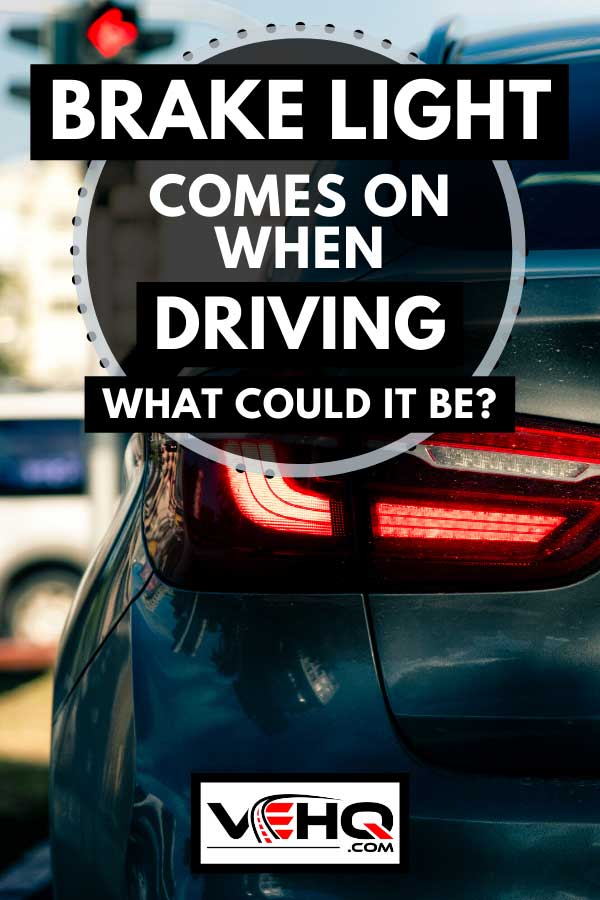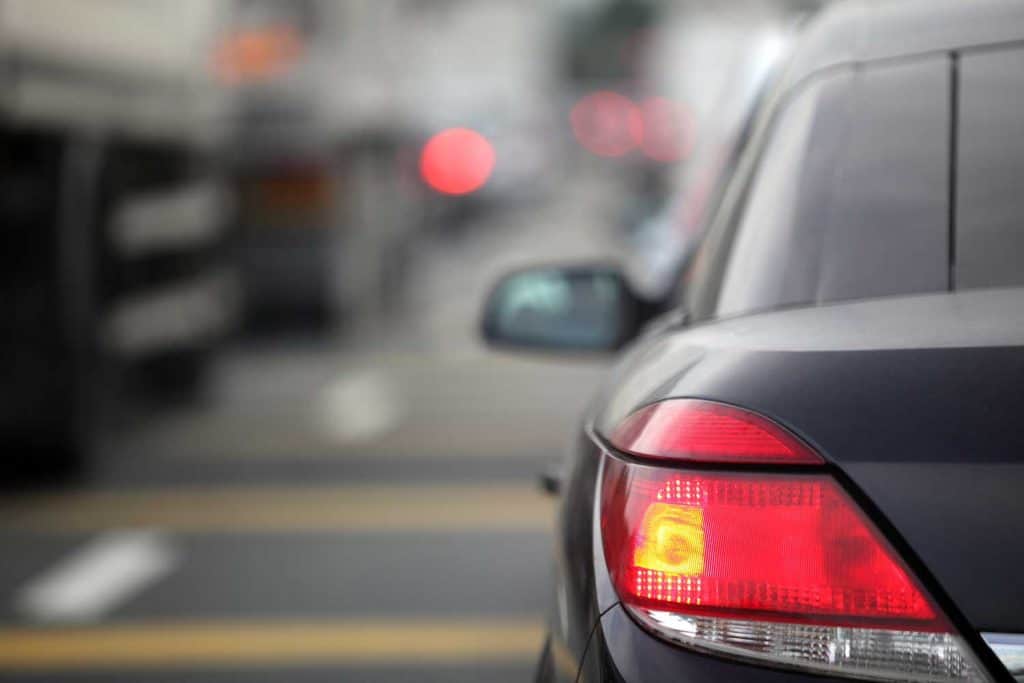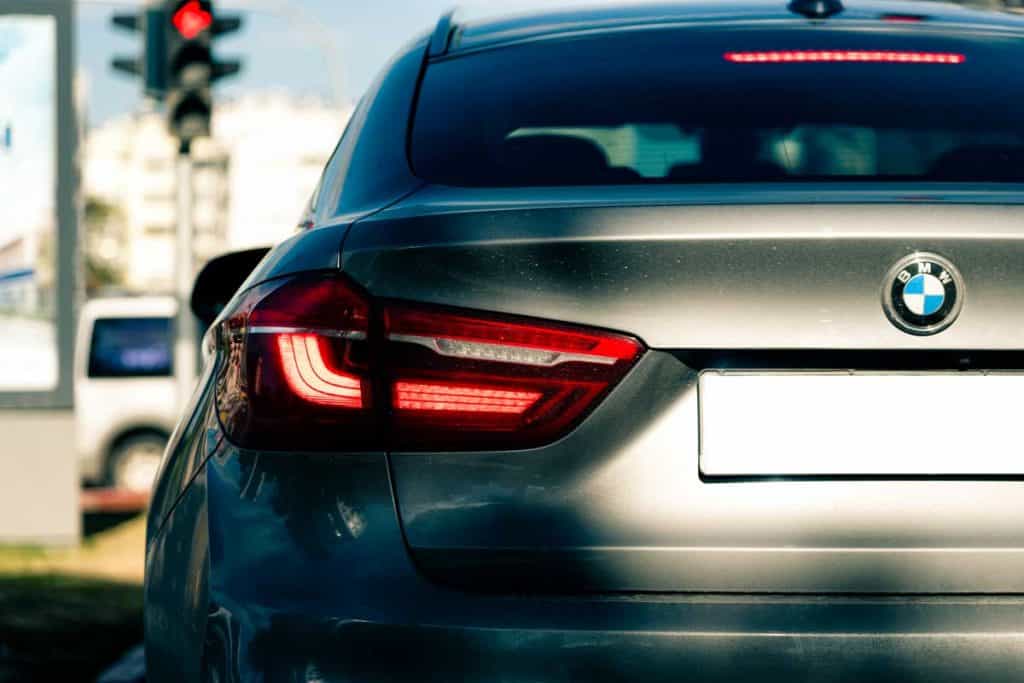 You know when your brake light should be on: to indicate that you’re braking. Yet lately, each time you drive your vehicle, that red light inevitably comes on. This is dangerous, as it could indicate something is wrong with your braking system. Why are your brake lights on when they shouldn’t be?
You know when your brake light should be on: to indicate that you’re braking. Yet lately, each time you drive your vehicle, that red light inevitably comes on. This is dangerous, as it could indicate something is wrong with your braking system. Why are your brake lights on when they shouldn’t be?
Your brake light could turn on when driving for the following reasons:
- The brake pads are old and need to be replaced.
- Your brake line is leaking.
- A master cylinder has insufficient brake fluid.
- The vehicle lacks hydraulic pressure, especially if only one brake light is coming on.
- Your parking brake may be on.
In this article, we’ll tell you everything you need to know about fixing this troublesome issue with your brake light. From whether you can drive with the brake lights on to how to reset your brake light, you’re not going to want to miss it.
As always, please take your vehicle mechanical issues extremely seriously. The information in this article is for educational and entertainment purposes only. Always talk to a qualified mechanical when it comes to diagnosing and fixing any car issues.
[toc]
What Does the Red Brake Light on the Dash Mean?
Your braking system is one of the most integral parts of your vehicle. If something has gone wrong with it, your car or truck will let you know with a red warning light on the dashboard. Depending on the model of your vehicle, this light may look quite different.
For example, sometimes, the warning light is red and says BRAKE. Other vehicles might display a warning brake light as a circle with two semicircles on both sides and an exclamation mark in the center. Here’s what the lights could look like.
Seeing such a light means you have a problem with your braking system. This is likely significant, as a less severe issue typically shows the light on your dash in a pale yellow instead of bright red.
Your Brake Pads Are Old
Brake pads are made of metal, ceramic, or plastic. As you put friction on the pads, they go from using kinetic energy to thermal energy. They usually come in pairs as part of a brake caliper, which has clamps that can press the pads together to roll your vehicle to a stop.
If your brake pads are past the point where they’re any good, your brake lights will come on, indicating a problem.
Master Cylinder Brake Fluid Issues
The master cylinder is another potentially troublesome area. This is what takes outside force and makes it into hydraulic pressure through slave cylinders and a hydraulic system. If you fail to maintain the master cylinder, it can fail on you.
The cylinder’s brake line can leak if it’s worn down, causing fluid levels to deplete faster than usual. You might have also forgotten to replace the master cylinder fluid, which can trigger your brake light into turning on as well.
Lack of Hydraulic Pressure
If your car or truck is outfitted with a hydraulic brake system, then the brake pedal creates a force that goes to the pedal, the master cylinder, and the booster. By adjusting pedal pressure manually, you can bring your car or truck to a safe stop.
If your vehicle begins losing hydraulic pressure, you’re at risk of brake failure. This can occur on one side of your car and even both sides in some instances. If only one side of your car or truck is affected, that brake light will stay on while the other turns off when not in use.
Your Parking Brake Is On
If you’ve checked the above areas and all seem to be in working order, take a moment to look at your parking brake. Is it on? You may not have set it this way on purpose, but either way, a parking brake that’s on will keep the brake light running.
Is It Safe to Drive When the Brake Light Is On?

The first time, you assumed it was a fluke, so you ignored it. Then you get into your car the next day, and the brake light is still on. Are you safe to go to work, school, or wherever your destination even if this light is glowing?
No! Your brake lights tell other motorists that you plan on stopping your vehicle. If your lights are on all the time, then you might find the vehicles around you give you a wide berth because they assume you’ll soon stop. If you continue driving at average speeds or even a little faster with your brake lights on, that’s a major miscommunication.
You could end up in an accident because the other motorist doesn’t react to you correctly. Since your brake lights were on, they would think you’re stopping, so the responsibility for the accident might be on you.
Even if other motorists don’t pay much attention to your brake lights being consistently on, it’s still not a safe idea to drive. Remember, brake lights indicate a problem with your brake system. Some of these aren’t huge issues right off the bat, but they can become so if you ignore them for long enough.
If any parts of your braking system quit working when you need them most, you might not be able to stop your vehicle in time. That again puts you at a considerable risk of an accident.
There is one place you can drive your car with brake lights that won’t turn off: your mechanic. Schedule an appointment with them immediately and see what they recommend for your brake light issues.
Oh, and if your mechanic ever says it’s safe to drive with brake lights on, such as this forum poster experienced, you might want to look for another mechanic.
Curious if you can drive when your dashboard lights up with other issues? Check out these articles: What Does the ABS Light Mean in a Car? | Can I Drive with the Check Engine Light On?
How Do I Reset My Brake Light?
Let’s say that after you saw your mechanic for your brake light issue that the lights still didn’t go out when they should. You have two options here. You can go back to your mechanic, or you can reset the brake light yourself.
How would you do the latter? Let’s explain.
The reason your brake warning lights are still glowing on your dashboard is due to an issue with the onboard diagnostics or OBD. The computer within has a code that’s causing the light to stay on. By deactivating that code, the light should turn off.
You want to begin by finding your assembly line diagnostic link port. If you’re in your vehicle’s dashboard, look beneath the control panel towards the bottom left. You should see the port there.
If you have an OBD scanner, which is recommended for this job, then connect it to the assembly line diagnostic link port. Also, put your car key in the ignition without turning on your vehicle. With your ODB scanner activated, a code should appear on its screen.
Check your car or truck’s service manual or go online to make sense of the code. Once you know what the code means, you might want to go back to the mechanic if that specific issue wasn’t already taken care of.
Otherwise, you can reconnect the OBD scanner to your assembly line diagnostic link port and put the key back in the ignition a second time. You still don’t want to turn on the vehicle, though. Within your ODB scanner, click “delete.” This should clear the code, so the brake warning lights finally go out.
To reiterate, you should not do this if the brake light is bothering you, and you haven’t seen a mechanic yet. Voiding the brake light does not mean the issue has gone away, only that you’re trying to forget about it. That’s not a smart choice for yourself and other motorists, as you become a liability on the road.

Why Does My e-Brake Light Keep Coming On?
An e-brake is just another way to refer to your parking brake. The “e” is short for emergency brake in this case. Some motorists refer to the parking brake as a hand brake as well, but they all mean the same thing.
Your parking brake may be located between the front and passenger seats, depending on the model of your vehicle. It’s a long, lean protrusion with a button on the end that you press to activate it. You could use your parking brake to assist when parking on an incline.
Each time you press the button on the parking brake, you should see your brake light come on. Then, when the parking brake is not in use, the light should go off. Of course, it doesn’t always work like this. If your parking brake turns on even when the e-brake is not in use, that’s a problem.
Here’s why your e-brake light may keep coming on and even staying on:
- The brake fluid pressure is not the same across all lines, causing an uneven buildup. Your car or truck may move more towards the side with more pressure, triggering the parking brake light to turn on.
- The master cylinder, when lacking fluid, can also trip your parking light brake.
- A lack of brake fluid can lead to you seeing the e-brake light. If you notice it comes on more when you turn or drive on rocky terrain, the liquid could be splashing around and tripping the light.
- If you don’t disengage your parking brake when you move the handle, or if the brake doesn’t register that it’s been disengaged, then your e-brake light won’t go off.
- Failing to lower the brake handle entirely can also cause the parking light brake to stay on.
- The switch within the parking brake can also cause you headaches. This can stop working completely or partially, leading to issues where sometimes the light is on, and other times, it’s off.
In Conclusion
If your brake light comes on when you’re driving, it’s usually due to an issue with the brake system. Don't ignore the brake light issue. See a mechanic right away so they can diagnose and repair your braking issue. It’s for your safety and the safety of others who share the road with you.
